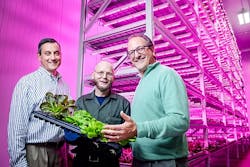Philips and Green Sense Farms harness LEDs for horticulture
Royal Philips has announced a partnership with Green Sense Farms to develop massive indoor commercial farming installations that leverage LED lighting to maximize plant productivity. The companies believe that tuned solid-state lighting (SSL) can yield 20–25 harvests per year while using 85% less energy than indoor horticultural installations that use legacy lighting.
Green Sense Farms has renovated 14 25-ft-tall growing towers in two climate-controlled rooms with Philips Lighting LED products.
As we have covered previously, LED lighting can yield a number of benefits in horticulture. Precise delivery of specific wavelengths can boost plant production and LED lighting offers the flexibility in terms of mechanical form factor for higher-density plant production in commercial farming settings. There are also benefits to LED lighting beyond directly accelerating plant development, as Valoya in The Netherlands has documented increased bee activity under SSL that results in improved tomato production.
The latest horticultural news from Philips involves a large commercial grower in Green Sense Farms based in the Chicago, Illinois area. The farm hopes that LEDs can help them produce more crops per year, use less energy, and locate growing operations near the consumer, thereby reducing the transportation cost of getting foods to market while delivering superior fresher produce to the consumer.
Green Sense Farms has renovated 14 25-ft-tall growing towers in two climate-controlled rooms with Philips Lighting LED products. The installation covers a one-million-ft3 growing space where the farm will take advantage of the low-profile and heat-free aspects of LED lighting to stack plants in a high-density fashion.
"By growing our crops vertically, we are able to pack more plants per acre than we would have in a field farm, which results in more harvests per year," said Robert Colangelo, founding farmer/president of Green Sense Farms. "We produce little waste, no agricultural runoff, and minimal greenhouse gases because the food is grown where it is consumed."
The LED installation will leverage Philips horticultural research. "Different plant types have different light needs and working with forward-thinking growers like Green Sense Farms, Philips is building up a database of light recipes for different plant varieties," said Udo van Slooten, director of horticultural lighting at Philips. "Green Sense Farms is using vertical hydroponic technology with Philips LED growing lights, enabling them to do what no other grower can do: Provide a consistent amount of high-quality produce, year round."
The partners believe that such operations will be critical in feeding a rapidly expanding global population base. The United Nations projects that global population will increase by 2.5 billion people by 2050. Moreover, 80% of that population will live in cities, making high-density urban farms a necessity.
Green Sense Farms hopes to build LED-lit growing operations located coincident with facilities such as college campuses, hospital complexes, and military bases to provide local produce production. "Through our joint R&D efforts with Philips, we continue to innovate and perfect LED lighting for indoor growing systems that can maximize plant photosynthesis, while minimizing energy use for the most delicious and nutritious vegetables grown in a sustainable manner," said Colangelo.
An article by consultancy Outsourced Innovation quantified some of the benefits in LED lighting in horticulture and also identified key actions for the industry going forward. Osram has also written on the subject of tuned LED spectrum for horticulture as well as other life-science applications.





